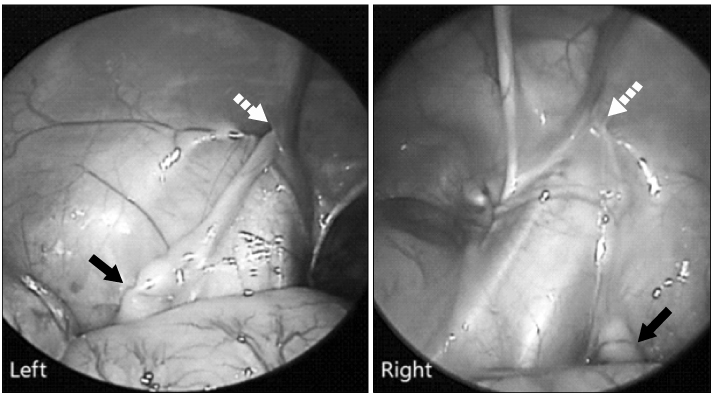Korean J Urol.
2009 Jun;50(6):615-618. 10.4111/kju.2009.50.6.615.
Bilateral Cryptorchidism in Silver-Russell Syndrome: Initial Experience with Laparoscopic Orchiopexy
- Affiliations
-
- 1Department of Urology, School of Medicine, Kyung Hee University, Seoul, Korea. yookoohan@yahoo.co.kr
- KMID: 1989797
- DOI: http://doi.org/10.4111/kju.2009.50.6.615
Abstract
- Silver-Russel syndrome (SRS) is a disorder present at birth that involves poor growth, low birth weight, differences in the size of the two sides of the body, and genital anomalies. The diagnosis is based on distinct prenatal growth restriction and the presence of typical dysmorphic features, including short stature and limb asymmetry. We report a case of bilateral cryptorchidism with no other genital anomalies in SRS. This report provides an overview of the genital anomalies of SRS and describes, for the first time, a laparoscopic orchiopexy in SRS.
MeSH Terms
Figure
Reference
-
1. Silver HK, Kiyasu W, George J, Deamer WC. Syndrome of congenital hemihypertrophy, shortness of stature, and elevated urinary gonadotropins. Pediatrics. 1953. 12:368–376.2. Russell A. A syndrome of intra-uterine dwarfism recognizable at birth with cranio-facial dysostosis, disproportionately short arms, and other anomalies (5 examples). Proc R Soc Med. 1954. 47:1040–1044.3. Kumar S, Jain A, Agrawal S, Chandran S. Silver-Russell syndrome: a case report. Cases J. 2008. 1:304.4. Choi K, Park T, Kim KS. Laparoscopic orchiopexy for intra-abdominal testis: complications and technical aspects. Korean J Urol. 2000. 41:420–424.5. Sperling H, Lümmen G, Schmidt C, Rübben H. Cryptorchidism: fowler-stephens procedure or autotransplantation-a new experimental model. Urology. 2000. 56:886–890.6. Hitchins MP, Stanier P, Preece MA, Moore GE. Silver-Russell syndrome: a dissection of the genetic aetiology and candidate chromosomal regions. J Med Genet. 2001. 38:810–819.7. Marks LJ, Bergeson PS. The Silver-Russel syndrome: a case with sexual ambiguity, and a review of the literature. Am J Dis Child. 1977. 131:447–451.8. Price SM, Stanhope R, Garrett C, Preece MA, Trembath RC. The spectrum of Silver-Russell syndrome: a clinical and molecular genetic study and new diagnostic criteria. J Med Genet. 1999. 36:837–842.9. Weiss GR, Garnick MB. Testicular cancer in a Russell-Silver dwarf. J Urol. 1981. 126:836–837.10. Haslam RH, Berman W, Heller RM. Renal abnormalities in the Russell-Silver syndrome. Pediatrics. 1973. 51:216–222.
- Full Text Links
- Actions
-
Cited
- CITED
-
- Close
- Share
- Similar articles
-
- Russell-Silver Syndrome
- Growth Hormone Therapy in Russell-Silver Syndrome
- Bone Age Determination and Hand Radiographic Findings in Children With Russell-Silver Syndrome
- A Case Report of Familial Silver-Russell Syndrome
- Prosthetic management of a growing patient with Russell-Silver syndrome: a clinical report




